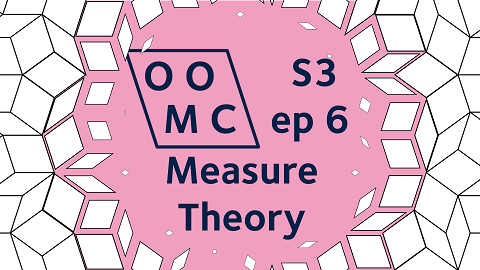Season 3 Episode 6

In this episode, what does it mean to measure something? Which things can we measure? And which branch of mathematics is this? Flora is on the livestream to explain!
Further Reading
Dice
Let’s think about another example of a measure space; rolling a fair six-sided die.
\begin{equation}
\Omega=\left\lbrace1,2,3,4,5,6\right\rbrace
\end{equation}
The powerset includes 64 different subsets (can you explain why?), and some of those subsets can be described in simple words like “the odd numbers” or “the even numbers” (where I suppose in those phrases, it’s understood that I mean the subset of odd numbers that are actually on the die). We’ll think about the measure function “probability that the outcome is in this subset”. For a fair die, this is a pretty simple measure function; $m(A)$ is just the number of elements in $A$ divided by six.
Thinking about a die that’s not fair, we could construct a more complicated measure function on the powerset of $\Omega$.
With finitely many items in $\Omega$, this resembles the discrete probability theory that you learn at school. Part of the power of measure theory is that we can move to continuous probability by considering measure functions on infinite sets.
For example, if I throw a dart a dartboard, then I could consider the sample space $\Omega$ of every point on the dartboard (and perhaps also points on the wall near-ish to the dart board). In this case, we could talk about my probability to hit a particular point-scoring region on the dart board. Perhaps it’s weird, but the actual thing that happens when I throw a dart has probability zero to happen! The event “hit this exact point” has zero measure. Any yet, when I throw a dart a dart board, one of these probability-zero events happens.
Set Theory – Empty Set
Flora introduced a symbol for the empty set (the set with no elements in); $\emptyset$.
I’ve just referred to that as “the” empty set, which is a little bit presumptuous of me.
Exercise: Prove that if $A$ and $B$ are both empty sets, then $A=B$ (remember that two sets $A$ and $B$ are the same if for every element in A, that element is in B, and vice versa).
Once you’ve done the exercise, we can talk about “the” empty set, rather than just “a” empty set.
Exercise: Prove that if $x$ is an element of $\emptyset$ then $x$ is prime number.
This is an example of a “vacuous truth”; it’s true because there’s essentially nothing to check. Note that this proof does not mean that $\emptyset$ is the set of all primes, and it does not mean that all (or indeed any) primes are in $\emptyset$.
Exercise: Prove that if $x$ is an element of $\emptyset$, then $x$ is also an elephant of $\emptyset$.
This means that we can talk about “the elephants of the empty set” interchangeably with “the elements of the empty set”.
Therefore, all the elephants of the empty set are prime numbers.
Set Theory – Countability
We had an OOMC session on countability last year – Season 2 Episode 10. That session goes through some examples of different “sizes” of infinity. These ideas of “size” are closely related to measure theory.
Lebesgue Measure
This feels like an appropriate time to try and describe the Lebesgue outer measure. This is a reasonable attempt to assign a sensible measure to each subset of the real numbers, which should match up with sensible things like $m((a,b))=|b-a|$ for the open interval $(a,b)$ (meaning the subset of the real numbers $a< x< b$).
The idea behind the Lebesgue outer measure is that we should try to cover our subset with open intervals and add up the measure of each of those open intervals, taking the smallest possible result if we have a choice, and taking the limit if we want to use (countably) infinitely many open intervals.
This seems sort of reasonable; and it’s a good enough definition for us to decide that the measure of the Cantor set is zero (as we did in the livestream).
There’s a strange problem though; there are subsets of the real numbers which cannot be measured with the definition above (the limit does not exist!). Their existence relies on a mildly controversial bit of mathematics called the Axiom of Choice. The Stanford Encyclopaedia of Philosophy website gives a good explanation of what this is.
If you want to get in touch with us about any of the mathematics in the video or the further reading, feel free to email us on oomc [at] maths.ox.ac.uk.

